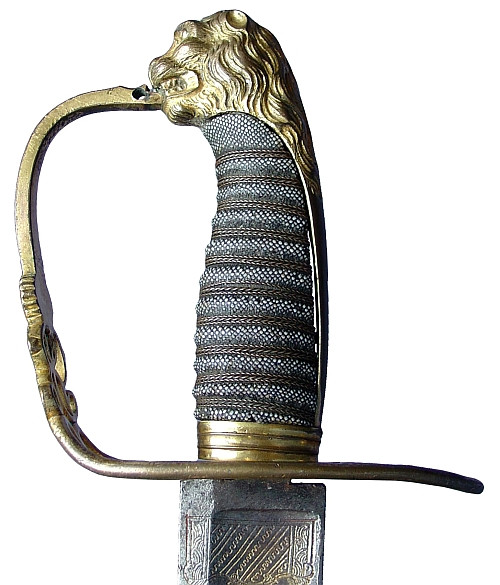 By 1800, this type of curved sabre had already been unofficially adopted by many light infantry officers, and it was only a matter of time before official recognition came in 1803. One of the most attractive of British pattern swords, it has numerous subtle variations in design, most notably to the royal cypher on the knuckle-bow and the lions-head pommel. The knucklebow can also feature either a bugle or flaming grenade above the royal crown, denoting use by both grenadiers and rifle companies. Blades were also lavishly decorated with blue and gilt. Its curved, cavalry type blade borrowed much from the eastern scimitar, and it quickly enjoyed quite a vogue amongst officers returning from the recent Egyptian campaigns. Although apparently unsuited to fighting on the ground (its curved blade would have been more effective when slashed from the saddle), style over substance seems to have won the day. Lieutenant William Smith of the 77th Foot (Middlesex Regiment) carried this pattern as he “hewed and slashed his way through the enemy” before succumbing to his many wounds at the Battle of Ciudad Rodrigo in the Peninsular War. Most examples are found without scabbards but it is worth holding on until you can locate a complete piece. This sword looks most attractive when paired with its gilt brass mounted scabbard. Examples with ivory grips were likely to have been carried by more senior officers.
By 1800, this type of curved sabre had already been unofficially adopted by many light infantry officers, and it was only a matter of time before official recognition came in 1803. One of the most attractive of British pattern swords, it has numerous subtle variations in design, most notably to the royal cypher on the knuckle-bow and the lions-head pommel. The knucklebow can also feature either a bugle or flaming grenade above the royal crown, denoting use by both grenadiers and rifle companies. Blades were also lavishly decorated with blue and gilt. Its curved, cavalry type blade borrowed much from the eastern scimitar, and it quickly enjoyed quite a vogue amongst officers returning from the recent Egyptian campaigns. Although apparently unsuited to fighting on the ground (its curved blade would have been more effective when slashed from the saddle), style over substance seems to have won the day. Lieutenant William Smith of the 77th Foot (Middlesex Regiment) carried this pattern as he “hewed and slashed his way through the enemy” before succumbing to his many wounds at the Battle of Ciudad Rodrigo in the Peninsular War. Most examples are found without scabbards but it is worth holding on until you can locate a complete piece. This sword looks most attractive when paired with its gilt brass mounted scabbard. Examples with ivory grips were likely to have been carried by more senior officers.
© Article by Harvey J S Withers – militariahub.com. Not to be reproduced without prior agreement.

